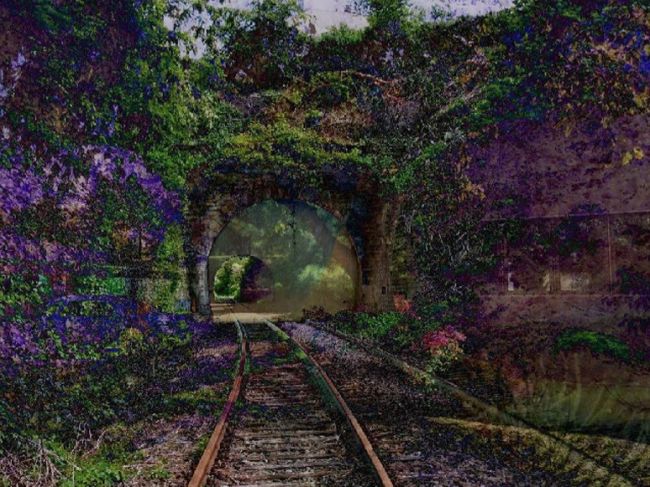Dr Thaler's latest attempt to obtain IP protection for "creations" of his AI system has failed, with a US Court rejecting copyright protection for an AI-generated artwork.
Background: Dr Thaler, DABUS and the Creativity Machine
Dr Thaler has become well-known as the owner of the DABUS AI which he has been seeking to have identified as the inventor of a patent at multiple patent offices around the world. So far he has done so without much success, although he is currently awaiting the outcome of an appeal in the UK Supreme Court.
Dr Thaler also owns an AI system he calls the "Creativity Machine" which generates art, he claims, of its own accord. In his latest foray into the world of IP registration, Dr Thaler sought to obtain copyright registration in the US for an artwork entitled "A Recent Entrance to Paradise", which he claimed was generated by the Creativity Machine.

"A Recent Entry to Paradise" (source)
Dr Thaler's application to the US Copyright Office identified the Creativity Machine as the copyright author, and he claimed that the ownership should transfer to him as "a work for hire" – a US term which means that ownership automatically transfer to the employer from the employee if copyright is generated by its employees if done within the scope of their employment hirer, which is similar to the employer ownership provisions of under UK and Australian law.
The US Copyright Office rejected his application on the grounds that the work lacked human authorship, which was a pre-requisite for valid copyright to be registered. Thaler had confirmed that the work was autonomously generated and acknowledged that it lacked "traditional human authorship" but had urged the Copyright Office to consider to "acknowledge [the Creativity Machine] as an author where it otherwise meets authorship criteria, with any copyright ownership vesting in the AI's owner". Following that decision, Thaler appealed to the District Court for the District of Columbia.
Court says no: copyright authors must be human
Last week the Court issued its appeal decision, in which it rejected Thaler's appeal and upheld the original decision that the work was not protected by copyright. In its reasons, the Court responded that although Thaler:
"...correctly observe[d] that throughout its long history, copyright has proven malleable enough to cover works created with or involving technologies developed long after traditional media of writings memorialized on paper ... Copyright has never stretched so far, however, as to protect works generated by new forms of technology operating absent any guiding human hand, as plaintiff urges here. Human authorship is a bedrock requirement of copyright."
In doing so, the Court noted there was "centuries of settled understanding" that an "author", for copyright purposes, must be a human, referring to previous decisions denying copyright protection for written works asserted to have been created by "celestial beings"1 and "a spirit named Phylos the Thibetan"2, a garden that "ow[ed] [its] form to the forces of nature",3 and photographs taken by a crested macaque that got its hands on a photographer's camera.4
Thaler's claims in relation to ownership were not relevant where there was no copyright in existence, and so did not need the Court's consideration.
Unanswered questions
Importantly, the Court observed because Thaler had identified the author of the work as the Creativity Machine, its decision was narrowly directed at "the sole issue of whether a work generated entirely by an artificial system absent human involvement should be eligible for copyright". Although in the course of the appeal Thaler had attempted to assert for the first time that he "provided instructions and directed his AI to create the Work", that "the AI is entirely controlled by [him]" and that "the AI only operates as [his] direction", the Court had to consider the application on the basis that he had originally sought it, namely that the work had been generated without human involvement.
As a consequence, the decision did not address what the Court described as "challenging questions" regarding:
"how much human input is necessary to qualify the user of an AI system as an "author" of a generated work, the scope of protection obtained over the resultant image, how to assess the originality of AI-generated works where the systems hay have been trained on unknown pre-existing works, how copyright might best be used to incentivize creative works involving AI, and more."
As we have previously observed, those questions are likely to be the key ones to be addressed by the Courts or legislatures in grappling with the application of copyright protection to AI-generated works. Given this decision, those questions remain open.
To read more on AI and copyright see our series The IP in AI and in particular the edition Does Copyright Protect AI-Generated Works?
Footnotes
1. Urantia Found. v. Kristen Maaherra, 11 F.3d 955, 958-59 (9th cir. 1997).
2. Oliver v. St. Germain Found., 41 F. Supp. 296, 297, 299 (S.D. Cal 1941).
3. Kelley v. Chicago Park District, 635 F.3d 290, 304-306 (7th Cit. 2011).
4. Naruti v. Slater, 888 F.3d 418, 420 (9th Cit. 2018).
The content of this article is intended to provide a general guide to the subject matter. Specialist advice should be sought about your specific circumstances.





